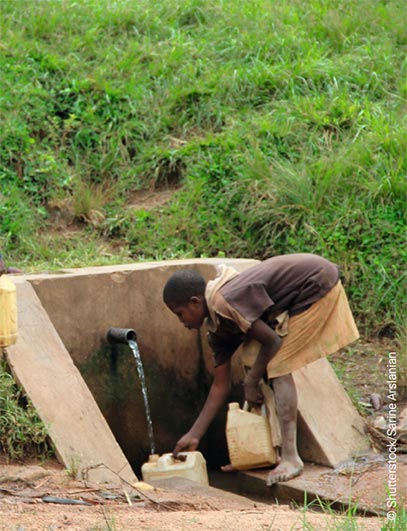
Provision of safe, reliable drinking water is a continuing goal of development institutions, requiring modernization of ageing infrastructure and construction of new infrastructure. In many parts of the world, the original infrastructure is deteriorating, requiring upgrading. Provision of drinking water services has not kept pace with the rate of urbanization in many Latin American and Caribbean cities (UNEP 2016f; World Health Organization [WHO] and United Nations Children’s Fund [UNICEF] 2016). The Millennium Development Goal (MDG) of halving the number of people without access to safe drinking water by 2015 was achieved by 2010, although progress was uneven across urban and rural populations in all regions (WHO and UNICEF 2015) (Figure 9.17).
In Asia and the Pacific, progress in provision of drinking water was significant, with 90 per cent of the population having access to improved water supply by 2015. Drinking water supply in Africa increased from 56 per cent in 1990 to 65 per cent in 2013, albeit mostly in urban areas, with 90 per cent of the urban population using improved water sources (UNEP 2016d).
There were significant improvements in access to drinking water in West Asia, with 89 per cent of the population having access to improved water supply by 2015. The reliability and continuity of service remains challenging, however, especially in conflict zones (UNEP 2016c; WHO and UNICEF 2016).
The relatively high quality of North American and Western European drinking water contributes to good public health, with these regions having some of the lowest rates of water-borne disease in the world. Most of the countries in these regions are party to the United Nations Economic Commission for Europe/ World Health Organization (WHO) Regional Office for Europe Protocol on Water and Health, and to the 1992 Convention on the Protection and Use of Transboundary Watercourses and International Lakes, a multilateral agreement committing countries to work actively to lower water-borne disease outbreaks (UNEP 2016a; UNEP 2016h).
Gender is a significant factor in water supply, with women and (mostly female) children continuing to carry the major burden and safety risks of acquiring and physically transporting water from source to place of use, particularly in developing countries, despite 1.5 billion more people gaining access to clean water since 2000 (WHO and UNICEF 2017; WHO and UNICEF 2012) (Figure 9.18).

The water collection time burden and the physical labour involved have implications for the livelihoods and safety of women and girls. Time spent by school-age girls collecting water competes with schooling (UNICEF and WHO 2012). It also reduces the ability of women to participate in other pursuits. It represents a substantial economic drain. Women in India spend an estimated 150 million workdays per year collecting and carrying water, the equivalent of a national income loss of 10 billion rupees (approximately US$160 million per year). The positive impacts of women being able to spend time on other activities should be widely acknowledged, since economic surveys indicate they typically reinvest up to 90 per cent of their income in their families, improving family health and nutrition, and increasing access to schooling for their children (Unilever et al. 2015).